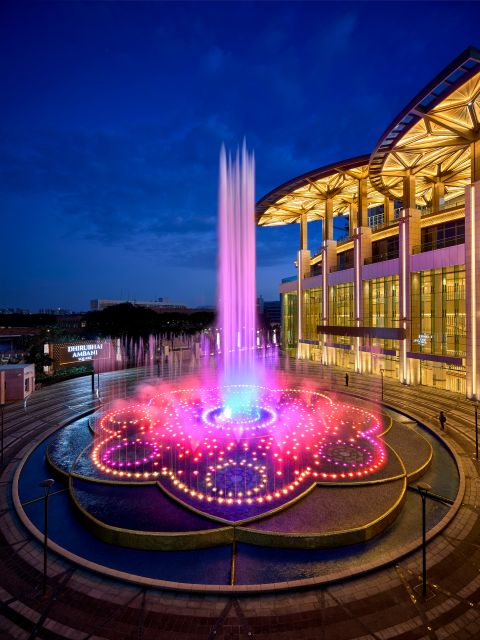
Nita Mukesh Ambani Cultural Centre:
My Visit to NMACC – A Place of Art with Heart in Mumbai
Last year I was fortunate enough to visit the Nita Mukesh Ambani Cultural Center – now this September it’s coming to you in New York at Lincoln Center!
No other country in the world has the riches of the arts that India has: 5000-year-old dance forms, music from classical to modern to jazz, hundreds of languages, theater of every dialect and visual arts from ancient to contemporary.
Now India also has a gorgeous jewel box to showcase these magnificent arts and performers – The Nita Mukesh Ambani Cultural Centre.
Cities are constantly changing and innovating, and my recent visit to the big, bustling city of Mumbai showed me many new wonders but perhaps the most mind-boggling is the grand Nita Mukesh Ambani Cultural Centre (NMACC) in the Bandra Kurla Complex of Mumbai. India is shining on the world stage now and so this was something a Maximum City like Mumbai needed – a maximum state-of-the-art venue to celebrate its culture and share with visitors from around the globe.
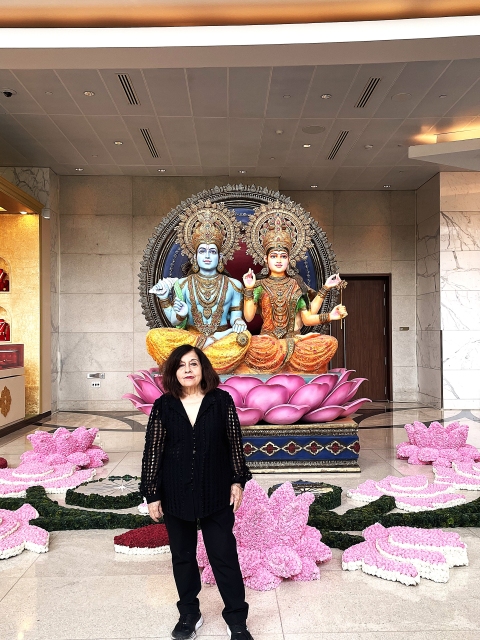
This being the creation of the astute Ambani family – India’s most powerful business house – culture, commerce and consumerism are all intermixed: this cultural center is embedded in the massive Jio World Center complex, so that all of them are next to each other and can meet all the needs that might arise in a fast-moving international city.
Yet, while the Cultural Center is very cutting-edge and the epitome of an international world class theater, it started from the small personal dream of a child who was growing up in this crowded city by the sea. Nita Ambani grew up as Nita Dalal in a middle-class family. She was only six years old when she embarked on her love affair with Indian dance – and grew up to be passionately dedicated to all of India’s art-forms. As the wife of Mukesh Dhirubhai Ambani, India’s richest billionaire industrialist, Nita Ambani, philanthropist and chairperson of the Reliance Foundation, founded The Nita Mukesh Ambani Cultural Centre, a performing arts and multi-disciplinary cultural and exhibition space on 31 March 2023.
This mighty edifice dedicated to culture in modern India had small beginnings in the seed of one young girl’s desire to preserve and protect the arts and crafts of India. Says Nita Ambani, “I stand before you as an artist and an Indian classical dancer. At the age of six, I made a choice to learn Bharat Natyam, a classical Indian dance form. It was a choice that empowered me, gave me confidence and helped shape the person I am today. I found my gift of expression and devotion in dance. For me, dance is a form of meditation. Something inside me connected so deeply to the world of arts.”
As her daughter Isha Ambani, who is co-director with her at the Centre, says, “My mom is a philanthropist, educationist, businesswoman, but at her core, her strongest identity is that of a dancer. For more than 50 years, she has danced every day. I have seen her dedicate time towards her craft. Her passion for the arts is unparalleled, and she’s always wanted to create a space dedicated to the heritage and culture of India. Over the past few years, my mother and I, along with our teams, have worked relentlessly towards making her dream come true.”
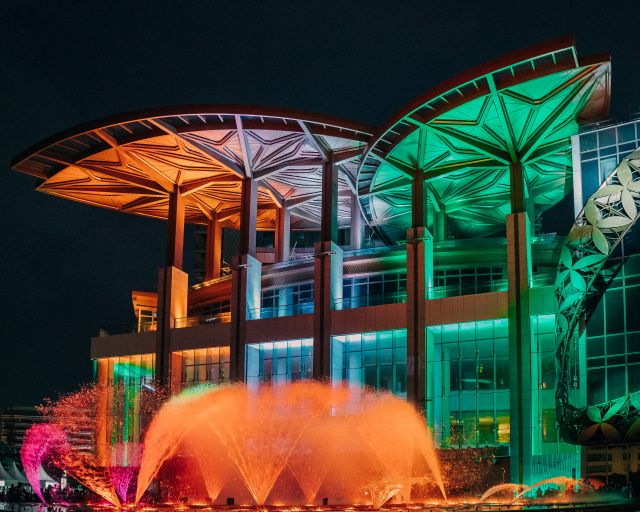
So appropriately enough, the opening evening of NMACC was marked by the debut of the theatrical experience The Great Indian Musical: Civilisation to Nation, celebrating Indian dance, drama, music and art by playwright and director Feroz Abbas Khan.
I was invited to explore the Centre on its off-day when the crowds would not be there, so I had the run of the place to myself. It was a strange sensation as if I was the sole inhabitant of this elaborate palace, without the added cacophony of multiple voices or the echoes of thousands of footfalls.
The Cultural Centre’s facade – right next to the Fountain of Joy – welcomes visitors with a larger-than-life cuff bracelet design, inspired by India’s rich heritage. This is also the place for tech programs, workshops, and educational events for the public.
“The NMACC is an ode to a nation,” says Nita Ambani. “I hope it can be a platform for Indian arts and culture, both for the audience and the artists, I hope that it will become a place that nurtures and inspires talent for years to come.”
I visited the three halls which encompass all kinds of shows from the biggest international openings to small, intimate workshops. Here technology is king. The Grand Theatre (- https://nmacc.com/venue-details/the-grand-theatre) is the most technologically advanced theater in India, with a combination of a world-class integrated Dolby Atmos Surround Sound System and Virtual Acoustic System, and a special programmable lighting system which is enhanced by over 8400 Swarovski crystals that are truly dazzling. It can seat 2000 people across various price levels, with 18 Diamond boxes with a special lounge.
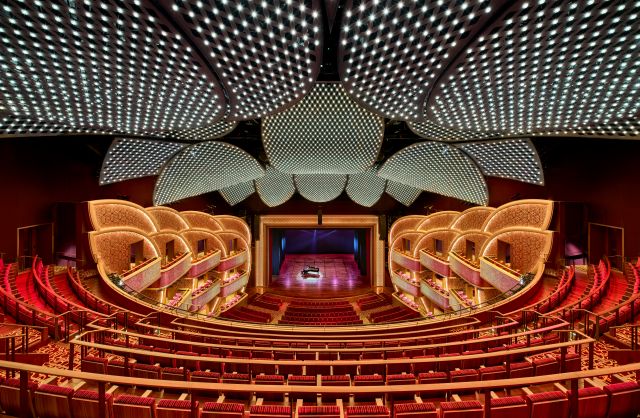
This theater can host any topnotch Broadway show as it is equipped with integrated recording and projection facilities, along with dedicated translation booths. Dedicated to latest trends in design, it uses special absorbent wood that reduces reflections. It also incorporates some of the best user-friendly traits of theaters abroad, such as assistive learning devices and is accessible for the disabled.
Some of the top international traveling shows have come here including ‘Sound of Music’ and ‘Life of Pi’. Now Indians don’t have to travel abroad to get a glimpse of the West End or Broadway. In the New Year you have ‘Phantom of the Opera’, the longest running show on Broadway at the Grand Theater for audiences to see – without leaving India!
Currently you have a medley of plays in different Indian languages, dance and musical performances. There are plays in Marathi, Gujarati and Hindi, Kathak and Bharat Natyam dance performances as well as classical musical evenings with noted artistes. A walk through the NMACC site’s calendar shows the breathtaking range of events, touching all aspects of Indian cultural life. There’s even The Kavaad Project’s ‘Maya’ a performance in Hindi verse devoted to the ancient Kavaad storytelling tradition which even so many in India don’t know about.
What about local home-grown shows and cultural shows? The Studio Theatre – (https://nmacc.com/venue-details/the-studio-theatre) is just the right space for more intimate shows by new artists as well as established artists. It features a telescopic seating system that allows seat transformation depending on the needs of the event and allows for artistic flexibility. It too has the Dolby Atmos Surround Sound System which makes it a very immersive experience for the audience. It also features a tension wire grid—the first-of-its-kind in India, which makes lighting and rigging during production flawless.
With a moveable stage and seating, the 125-seat Cube can be transformed to host a variety of performances, making it an incubator of new art forms and the go-to platform for discovering innovative new-age talent. The space also features a Panasonic Laser projection system and an Assisted Listening system with infrared emitters to make each performance feel more real than ever. Adding to the cutting-edge technology within the space is a fully integrated video recording and production setup and 5G connectivity, making filming and streaming live performances a lot simpler. The Cube encourages and promotes emerging Indian artists from new and experimental theatre, spoken word, stand-up comedy and music.
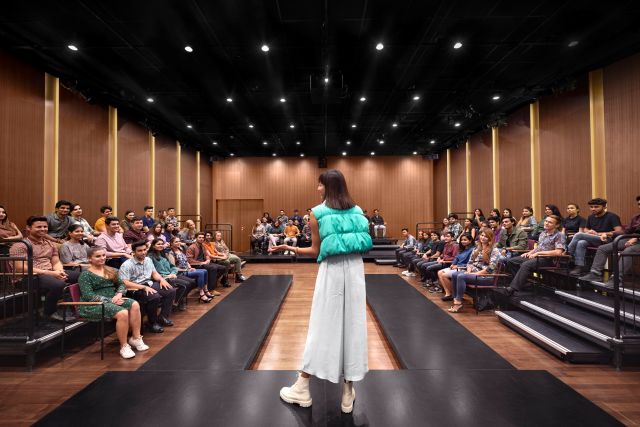
Then there’s the Art House (- https://nmacc.com/venue-details/art-house) which can compare to any world-class museum. This four-story dedicated art space is designed to showcase a shifting array of installations and exhibits that brings the treasures of Indian and global art to the audience. Keeping community building and collaboration at its core, the Art House encourages new talent and enables India to see the world through a wider cultural lens.
Being a repository of art and culture, the center hosts several prominent public art installations including Kamal Kunj – One of the largest commissioned Pichwai paintings at 56 feet tall, with depictions of seasonal festivities; Clouds – A 90-piece set of stainless steel structure mirrors by Yayoi Kusama, displayed on the ground; Seekers Paradise – An installation art piece by N. S. Harsha; Closet Quarries I & II – A painting by Reena Kallat using rubber stamps, reflecting the names of craftsmen and symbols seen in Mughal monuments; Earth’s Whisper – A work by Jagannath Panda around the idea ‘Contribution is Growth’.
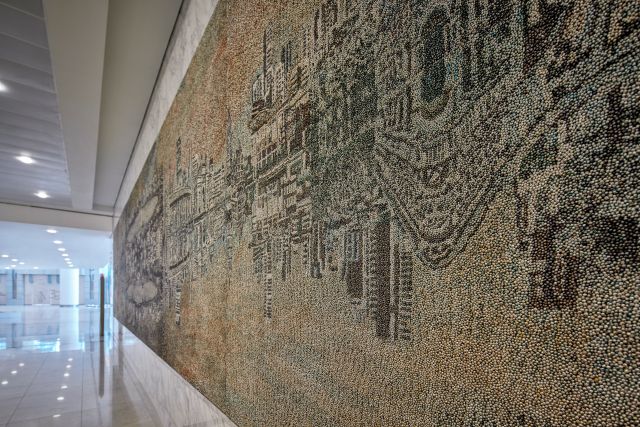
Other memorable art pieces include Mechanism 12 – A work by Tanya Goel uses pigments from the sites of architectural demolitions in and around Delhi: City Obscure – Vibha Galhotra’s cityscape of Mumbai takes up an entire wall and is made from leitmotif ghungroos, small ankle bells in Indian culture; Arboretum I – A work by artist duo Thukral & Tagra, comprising illustrations of over 60 floral species from across India.
Fashion is the highlight of a big exhibit which ran in 2023. India in Fashion: The Impact of Indian Dress and Textiles on the Fashionable Imagination’. As the noted designer Manish Malhotra says: “Nita has always been an avid supporter of uplifting the age-old crafts that constitute the cultural legacy of our country, and we have been united by our shared love for heritage-driven crafts. The NMACC is where we will get to see more of the untouched arts of India, and this will hopefully be the beginning for the awakening of appreciation for our profound culture.”
Perhaps the most important part of the arts centre is Swadesh, Nita Ambani’s tribute to the crafts and forgotten craftspeople of India who are a dying breed unless efforts such as these strengthen and fortify crafts as a viable option of livelihood. Swadesh, an India-inspired art and craft exposition, celebrates this legacy through an ever-evolving showcase of regional artistry from across the nation. It serves as an interactive platform where master artisans share their crafts and stories with visitors from around the world. Nita Ambani has worked with these weavers and crafts people for a long time, through Reliance Foundation.
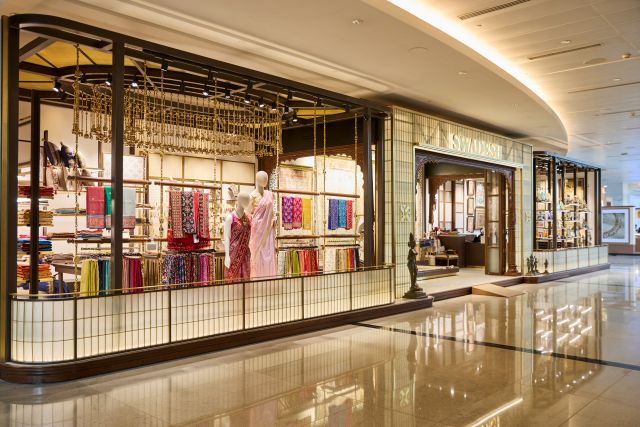
Since its inception, Swadesh has become a cornerstone of the Cultural Centre, transforming the Level 0 concourse into an introduction to India’s living crafts. Each pavilion is a living tribute to its region, inviting visitors to experience the artistry through meaningful conversations and live demonstrations. This showcase has celebrated over 30 iconic Indian crafts so far, each with a story as colorful and compelling as the art itself. Swadesh has played a pivotal role in preserving and nurturing the growth of traditional crafts like Pichwai painting, Sozni embroidery, and Blue Pottery.
This winter visitors will get to see craftspeople working on Kanjivaram silk of Tamil Nadu, Banarasi brocade from Varanasi, Thewa jewellery of Rajasthan, Thangka paintings from Ladakh and Sikkim, and Sunrise Candles from Maharashtra. Each craft has a fascinating story behind it, going centuries into the past. Hailing from the sacred town of Kanchipuram, Kanjivaram silk sarees are best known for their lush hues, intricate designs, and unparalleled craftsmanship. Steeped in legend, the weavers of Kanjivaram are believed to trace their heritage to Sage Markanda, the divine master weaver of the Gods. Each saree is a masterpiece, meticulously woven using the age-old korvai technique, where borders are crafted with real gold or silver zari.
Kanjivaram sarees are more than just garments — they are a canvas of cultural storytelling, with motifs drawn from temple architecture, mythological epics, and the natural world
Originating from the vibrant town of Pratapgarh in Rajasthan, Thewa jewellery is a centuries-old craft that fuses delicate gold designs with colored glass, creating pieces of breathtaking beauty. Today, just 12 families in Pratapgarh continue to preserve this rich legacy. Each piece of Thewa tells a story — depicting scenes of nature, royal life, and majestic hunts. Celebrated globally, these creations have found a place in prestigious museums like the Metropolitan Museum of Art and the Victoria and Albert Museum.
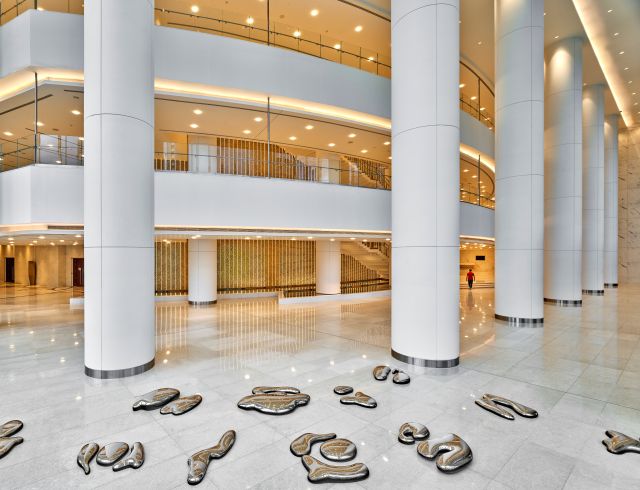
It’s also about providing livelihoods for the craftspeople, including the sightless. Sunrise Candles, founded by Dr. Bhavesh Chandubhai Bhatia, tells a story of empowerment and social transformation in Maharashtra. Unlike traditional crafts, this initiative offers employment to the visually impaired, who handcraft a range of candles of beauty and utility.
The whole complex is gargantuan where big events, including world conventions and big fat Indian weddings are held. When they told me they were taking me into the elevator, I did not quite realize that the huge sitting room-sized contraption was the elevator! This was made with a big audience and big wedding crowds in mind. And so, although it was just the two of us riding it, the elevator could have easily accommodated a few hundred more.
Strategically located in the heart of BKC, Mumbai, Jio World Plaza sits on the cusp of the Island City (south Mumbai), western and eastern suburbs. As a one-of-a-kind luxury retail destination, Jio World Plaza is a part of the Jio World Centre, the multifaceted landmark which is spread across 18.5 acres in Bandra Kurla Complex.
The Jio World Plaza houses flagship stores of noted global names like Louis Vuitton, Gucci, Dior, Cartier, Bally, and Giorgio Armani. Acclaimed Indian couturiers Manish Malhotra, Abu Jani Sandeep Khosla, and Rahul Mishra have also opened stores in this luxury mall which also has world-class cinema complexes, cafes and restaurants.
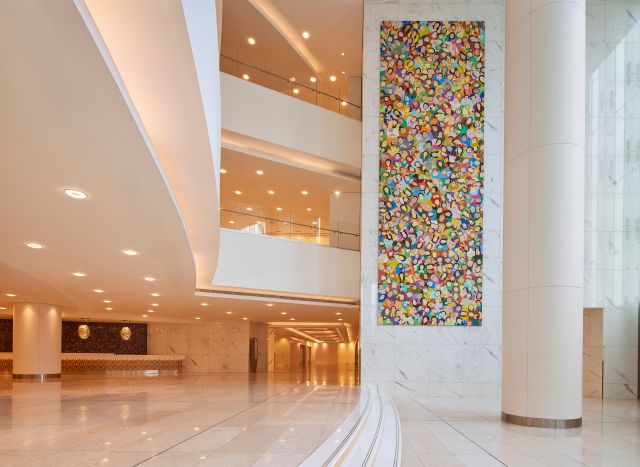
At its heart, this jewel box remains very much a part of the sustainability culture of the future: it is Platinum LEED Complaint and is surrounded by over 700 native trees. Nearly 75% of all regularly occupied areas are designed to receive natural daylight, resulting in
The Jio World Plaza reimagines public spaces where art and architecture seamlessly come together. Designed by TVS, a US-based design firm, its architecture is a juxtaposition of modernity and timeless Indianness. Inspired by the organic shapes found in nature and the lotus, its layout is a refreshing take on a retail destination of the future.
In the end, it’s very much a people’s house as anyone from the streets can come to Dhirubhai Ambani Square to enjoy a bird’s eye view of the Fountain of Joy and the stunning water, lights and music show which is held every week from Wednesday through Sunday. They do have to get a pass via their mobiles for the entry but it’s free to see this choreographed show with water jets of changing color shooting 45 feet high to synchronized music. The café too is one where items are economically priced so that a middle-class family can eat out together, even without attending a performance.
Hundreds of thousands of visitors, both local and international, have passed through the doors of the arts center to see a show, experience the crafts or stage a family weddIng. Aroon Shivdasani of New York is one such visitor. The founder of the award-winning Indo-American Arts Council, she says: “The Ambani Center is spectacular. It is impressive but not flashy. It has beautiful artwork on the walls, the ceilings and the restaurants. I saw Feroz Khan’s Mughal-e -Azam in the amazing new auditorium and was blown away by the perfect acoustics, the wide seats and the arrangement of the rows to ensure every member of the audience got a perfect view of the stage.”
Shivdasani, who is an art collector and supporter of the arts, observes that she thoroughly enjoyed a wonderful exhibition of the biggest names in American pop art including Andy Warhol, Roy Liechtenstien, Claes Oldenberg, Keith Herring, Ed Ruscha in the upstairs gallery, curated by Lawrence Van Hagen. She adds, “The Nita Ambani Centre is a cultural haven for both artists and audiences. Artists have several smaller auditoriums and rehearsal spaces to work in; while for audiences, it is well worth trotting out to Bandra to indulge in the multiple cultural presentations there and then finish off the day with a mouthwatering meal in one of the restaurants in the center.”
From nurturing aspiring artists to showcasing India’s crafts and talent to the world and bringing global artistes to India, a young girl’s improbable dream has become a reality and today the Nita Ambani Cultural Centre is a blueprint and a talisman for young Indians yearning to create a new and vibrant India.
(This article first appeared in Hinduism Today. Lavina Melwani is a writer for several international publications and blogs at Lassi with Lavina.)
